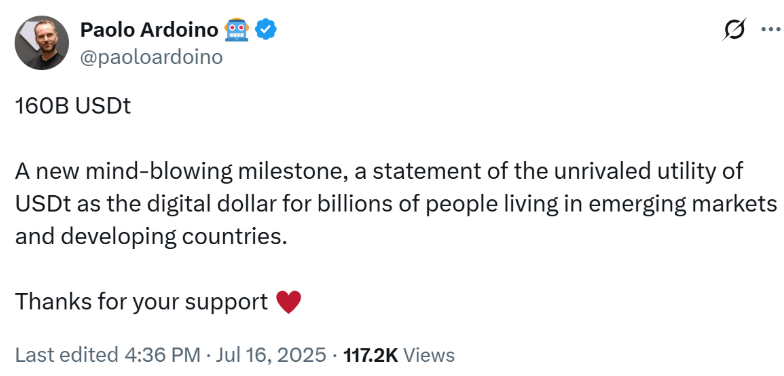Tether’s USDt, the largest stablecoin by market capitalization, has officially crossed the $160 billion mark, solidifying its reputation as the leading digital dollar alternative across emerging markets and global crypto ecosystems.
USDt Demand Surges Across Emerging Markets
Tether CEO Paolo Ardoino described this milestone as a “mind-blowing achievement,” emphasizing its role as a lifeline for over 400 million people in developing economies. The number of wallets holding USDt reportedly grows by 35 million each quarter, indicating the stablecoin’s increasing real-world utility.

The $160 billion market cap milestone follows a sharp increase from $150 billion in May 2025.
This growing adoption highlights how stable digital currencies are becoming more than just trading instruments—they’re transforming into everyday financial tools.
Tron Dominates USDt Blockchain Distribution
A breakdown of USDt supply by blockchain shows Tron leads with over $81 billion, followed by Ethereum with approximately $65 billion. Other networks such as BNB Chain, Solana, and Polygon collectively account for less than $10 billion.
Tron’s scalability and low transaction costs are key reasons it dominates USDt circulation.
This distribution shows how blockchain infrastructure plays a direct role in stablecoin adoption across different regions and use cases.
Tether’s Reserves Include $127 Billion in U.S. Treasurys
According to the latest reserve data, 81.5% of USDt is backed by cash and cash equivalents, mostly short-term U.S. Treasurys. Tether currently holds over $127 billion in Treasurys, placing it among the top 20 holders globally, alongside sovereign nations like Germany and South Korea.
Bitcoin represents 5.1% of Tether’s backing reserves, reflecting a diversified but conservative asset mix.
Tether also reported $1 billion in operating profits in Q1 2025, adding financial strength to the stablecoin issuer’s foundation.
Stablecoin Regulation and Blockchain Strategy
Tether recently announced it will discontinue USDt redemptions on five legacy blockchains starting September 1, including Omni Layer, Bitcoin Cash SLP, Kusama, EOS, and Algorand. The move is aimed at focusing resources on more scalable, developer-active networks.
Meanwhile, regulatory clarity around stablecoins continues to grow. The GENIUS Act, a major bipartisan bill supporting stablecoin oversight, is under debate in the U.S. Congress. If passed, it could open the door for mainstream institutional adoption.
Disclaimer
This content is for informational purposes only and does not constitute financial, investment, or legal advice. Cryptocurrency trading involves risk and may result in financial loss.
